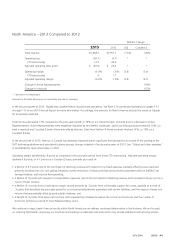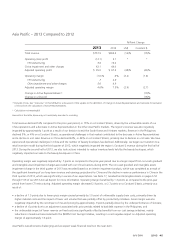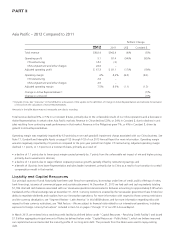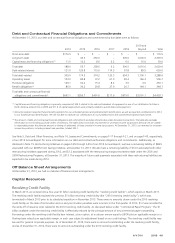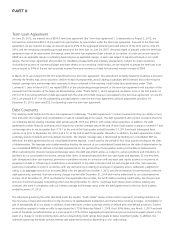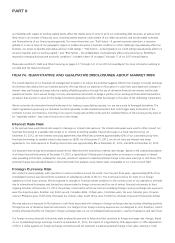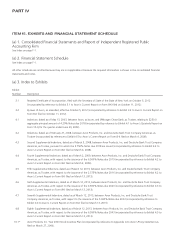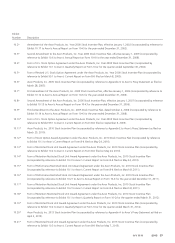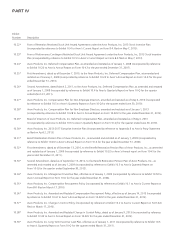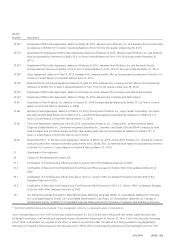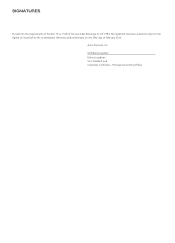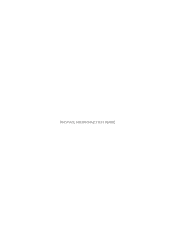Avon 2013 Annual Report Download - page 61
Download and view the complete annual report
Please find page 61 of the 2013 Avon annual report below. You can navigate through the pages in the report by either clicking on the pages listed below, or by using the keyword search tool below to find specific information within the annual report.flows. This potential change does not consider our underlying foreign currency exposures. The hypothetical impact was calculated on the
open positions using forward rates at December 31, 2013, adjusted for an assumed 10% appreciation or 10% depreciation of the U.S.
dollar against these hedging contracts.
Credit Risk of Financial Instruments
We attempt to minimize our credit exposure to counterparties by entering into derivative transactions and similar agreements with major
international financial institutions with “A” or higher credit ratings as issued by Standard & Poor’s Corporation. Our foreign currency and
interest-rate derivatives are comprised of over-the-counter forward contracts, swaps or options with major international financial institutions.
Although our theoretical credit risk is the replacement cost at the then estimated fair value of these instruments, we believe that the risk of
incurring credit risk losses is remote and that such losses, if any, would not be material.
Non-performance of the counterparties on the balance of all the foreign exchange agreements would have resulted in a write-off of $3.4 at
December 31, 2013. In addition, in the event of non-performance by such counterparties, we would be exposed to market risk on the
underlying items being hedged as a result of changes in foreign exchange rates.
See Note 8, Financial Instruments and Risk Management on pages F-26 through F-29 of our 2013 Annual Report for more information.
ITEM 8. FINANCIAL STATEMENTS AND SUPPLEMENTARY DATA
Reference is made to the Index on page F-1 of our Consolidated Financial Statements and Notes thereto contained herein.
ITEM 9. CHANGES IN AND DISAGREEMENTS WITH ACCOUNTANTS ON
ACCOUNTING AND FINANCIAL DISCLOSURE
Not applicable.
ITEM 9A. CONTROLS AND PROCEDURES
Evaluation of Disclosure Controls and Procedures
As of the end of the period covered by this report, our principal executive and principal financial officers carried out an evaluation of the
effectiveness of the design and operation of our disclosure controls and procedures pursuant to Rule 13a-15 of the Securities Exchange Act
of 1934, as amended (the “Exchange Act”). In designing and evaluating our disclosure controls and procedures, management recognizes
that any controls and procedures, no matter how well designed and operated, can provide only reasonable assurance of achieving the
desired control objectives, and management was required to apply its judgment in evaluating and implementing possible controls and
procedures. Based upon their evaluation, the principal executive and principal financial officers concluded that our disclosure controls and
procedures were effective as of December 31, 2013, at the reasonable assurance level. Disclosure controls and procedures are designed to
ensure that information relating to Avon (including our consolidated subsidiaries) required to be disclosed by us in the reports we file or
submit under the Exchange Act is recorded, processed, summarized and reported within the time periods specified in the United States
Securities and Exchange Commission’s rules and forms and to ensure that information required to be disclosed is accumulated and
communicated to management to allow timely decisions regarding disclosure.
Management’s Report on Internal Control over Financial Reporting
Our management is responsible for establishing and maintaining adequate internal control over financial reporting, as such term is defined
in Rule 13a-15(f) under the Exchange Act. Internal control over financial reporting is defined as a process designed by, or under the
supervision of, our principal executive and principal financial officers and effected by our Board of Directors, management and other
personnel, to provide reasonable assurance regarding the reliability of financial reporting and the preparation of financial statements for
external purposes in accordance with generally accepted accounting principles, and includes those policies and procedures that:
• pertain to the maintenance of records that, in reasonable detail accurately and fairly reflect the transactions and dispositions of our assets;
• provide reasonable assurance that transactions are recorded as necessary to permit preparation of financial statements in accordance with
generally accepted accounting principles, and that our receipts and expenditures are being made only in accordance with authorizations
of our management and directors; and
• provide reasonable assurance regarding prevention or timely detection of unauthorized acquisition, use or disposition of our assets that
could have a material effect on the financial statements.
A V O N 2013 53


